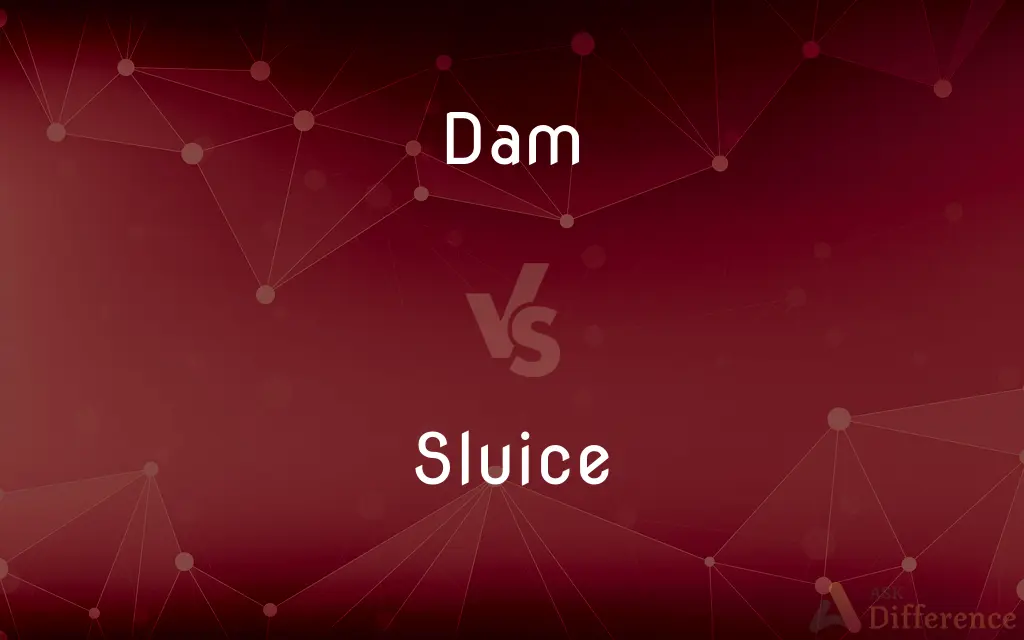Dam vs. Sluice — What's the Difference?
By Urooj Arif & Fiza Rafique — Updated on March 28, 2024
A dam is a barrier that stops or restricts the flow of water or underground streams, while a sluice is a structure for controlling water flow in a channel, often for water management or gold mining.

Difference Between Dam and Sluice
Table of Contents
ADVERTISEMENT
Key Differences
A dam is primarily designed to store water in a reservoir for purposes such as irrigation, human consumption, industrial use, aquaculture, and hydroelectric power generation. On the other hand, a sluice is used to regulate water flow and sediment in a controlled manner, primarily for irrigation, water treatment, and mining activities.
Dams are often massive structures built with concrete, earth, or rock, capable of holding back large volumes of water and creating lakes or reservoirs. Whereas sluices are smaller, consisting of gates and channels that can be adjusted to manage water flow and are commonly found in water treatment plants, agricultural lands, and gold mining areas.
The construction of a dam is a significant engineering project that requires careful planning, environmental assessments, and substantial investment. In contrast, sluices are relatively simpler to construct and operate, making them a cost-effective solution for specific water management needs.
Dams play a critical role in flood control, helping to protect downstream communities from the devastating effects of floods. Sluices, while also used for flood management, primarily focus on managing water levels in canals and rivers to ensure adequate water supply for irrigation and other uses.
The environmental impact of dams includes habitat disruption, changes in water quality, and affecting local ecosystems. Sluices, though having an environmental impact, tend to have a lesser footprint due to their smaller size and more targeted application in water management.
ADVERTISEMENT
Comparison Chart
Purpose
Stores water for various uses
Controls water flow for management
Construction
Large, requires extensive planning
Smaller, simpler to construct
Application
Irrigation, consumption, power generation
Irrigation, water treatment, mining
Environmental Impact
Can significantly alter ecosystems
Lesser impact, more targeted use
Flood Control
Provides significant protection
Manages water levels, lesser protection
Compare with Definitions
Dam
A source of water for irrigation.
Farmers rely on the dam's reservoir to water their crops.
Sluice
A sliding gate or other device for controlling the flow of water.
The farmer opened the sluice to irrigate his fields.
Dam
A barrier constructed to hold back water and raise its level.
The Hoover Dam creates a large reservoir used for electricity generation.
Sluice
Helps in managing water levels in canals.
The sluice gates were adjusted to prevent flooding.
Dam
Used in hydroelectric power generation.
The new dam generates electricity for thousands of homes.
Sluice
Used in gold mining to separate gold from sediment.
Miners use sluices to wash away the lighter material.
Dam
A structure built across a river to control its flow.
The dam near our town was built to prevent flooding.
Sluice
Part of water treatment processes.
Sluices are used in the plant to control the flow of wastewater.
Dam
Can create recreational areas.
The lake formed by the dam is a popular spot for boating and fishing.
Sluice
A channel for conveying water.
The sluice channels water from the river through the village.
Dam
A dam is a barrier that stops or restricts the flow of surface water or underground streams. Reservoirs created by dams not only suppress floods but also provide water for activities such as irrigation, human consumption, industrial use, aquaculture, and navigability.
Sluice
Sluice ( SLOOS) is a Dutch word for a channel controlled at its head by a movable gate which is called a sluice gate . A sluice gate is traditionally a wood or metal barrier sliding in grooves that are set in the sides of the waterway and can be considered as a bottom opening in a wall .
Dam
A barrier constructed to hold back water and raise its level, forming a reservoir used to generate electricity or as a water supply
The dam burst after torrential rain
The Hoover Dam
Sluice
An artificial channel for conducting water, with a valve or gate to regulate the flow
Sluices connecting a reservoir with irrigated fields.
Dam
A rubber sheet used to keep saliva from the teeth during dental operations, or as a prophylactic device during cunnilingus and anilingus.
Sluice
A valve or gate used in such a channel; a floodgate
Open sluices to flood a dry dock. Also called sluice gate.
Dam
The female parent of an animal, especially a domestic mammal.
Sluice
A body of water impounded behind a floodgate.
Dam
Build a dam across (a river or lake)
The river was dammed to form Lake Powell
Sluice
A sluiceway.
Dam
A barrier constructed across a waterway to control the flow or raise the level of water.
Sluice
A long inclined trough, as for carrying logs or separating gold ore.
Dam
A body of water controlled by such a barrier.
Sluice
To flood or drench with or as if with a flow of released water.
Dam
A barrier against the passage of liquid or loose material, as a rubber sheet used in dentistry to isolate one or more teeth from the rest of the mouth.
Sluice
To wash with water flowing in a sluice
Sluicing sediment for gold.
Dam
A female parent of an animal, especially a domesticated mammal such as a horse.
Sluice
To draw off or let out by a sluice
Sluice floodwater.
Dam
(Archaic) A mother.
Sluice
To send (logs, for example) down a sluice.
Dam
To hold back or confine by means of a dam.
Sluice
To flow out from or as if from a sluice.
Dam
To close up; obstruct
He tried to dam his grief.
Sluice
An artificial passage for water, fitted with a valve or gate, for example in a canal lock or a mill stream, for stopping or regulating the flow.
Dam
A structure placed across a flowing body of water to stop the flow or part of the flow, generally for purposes such as retaining or diverting some of the water or retarding the release of accumulated water to avoid abrupt flooding.
A dam is often an essential source of water to farmers of hilly country.
Sluice
A water gate or floodgate.
Dam
The water reservoir resulting from placing such a structure.
Boats may only be used at places set aside for boating on the dam.
Sluice
Hence, an opening or channel through which anything flows; a source of supply.
Dam
(dentistry) A device to prevent a tooth from getting wet during dental work, consisting of a rubber sheet held with a band.
Sluice
The stream flowing through a floodgate.
Dam
A reservoir.
Sluice
(mining) A long box or trough through which water flows, used for washing auriferous earth.
Dam
A firebrick wall, or a stone, which forms the front of the hearth of a blast furnace.
Sluice
(linguistics) An instance of wh-stranding ellipsis, or sluicing.
Dam
Female parent, mother, generally regarding breeding of animals.
Sluice
To emit by, or as by, flood gates.
Dam
A kind of crowned piece in the game of draughts.
Sluice
(transitive) To wet copiously, as by opening a sluice
Dam
(India) An obsolete Indian copper coin, equal to a fortieth of a rupee.
Sluice
(transitive) To wash with, or in, a stream of water running through a sluice.
To sluice earth or gold dust in a sluice box in placer mining
Dam
A former coin of Nepal, 128 of which were worth one mohar.
Sluice
To wash (down or out).
Dam
(transitive) To block the flow of water.
Sluice
(intransitive) To flow, pour.
Dam
Damn.
Sluice
(linguistics) To elide the complement in a coordinated wh-question. See sluicing.
Dam
Damn.
Sluice
An artifical passage for water, fitted with a valve or gate, as in a mill stream, for stopping or regulating the flow; also, a water gate or flood gate.
Dam
A female parent; - used of beasts, especially of quadrupeds; sometimes applied in contempt to a human mother.
Our sire and dam, now confined to horses, are a relic of this age (13th century) . . . .Dame is used of a hen; we now make a great difference between dame and dam.
The dam runs lowing up and down,Looking the way her harmless young one went.
Sluice
Hence, an opening or channel through which anything flows; a source of supply.
Each sluice of affluent fortune opened soon.
This home familiarity . . . opens the sluices of sensibility.
Dam
A king or crowned piece in the game of draughts.
Sluice
The stream flowing through a flood gate.
Dam
A barrier to prevent the flow of a liquid; esp., a bank of earth, or wall of any kind, as of masonry or wood, built across a water course, to confine and keep back flowing water.
Sluice
A long box or trough through which water flows, - used for washing auriferous earth.
Dam
A firebrick wall, or a stone, which forms the front of the hearth of a blast furnace.
Sluice
To emit by, or as by, flood gates.
Dam
To obstruct or restrain the flow of, by a dam; to confine by constructing a dam, as a stream of water; - generally used with in or up.
I'll have the current in this place dammed up.
A weight of earth that dams in the water.
Sluice
To wet copiously, as by opening a sluice; as, to sluice meadows.
He dried his neck and face, which he had been sluicing with cold water.
Dam
To shut up; to stop up; to close; to restrain.
The strait pass was dammedWith dead men hurt behind, and cowards.
Sluice
To wash with, or in, a stream of water running through a sluice; as, to sluice eart or gold dust in mining.
Dam
A barrier constructed to contain the flow of water or to keep out the sea
Sluice
Conduit that carries a rapid flow of water controlled by a sluicegate
Dam
A metric unit of length equal to ten meters
Sluice
Pour as if from a sluice;
An aggressive tide sluiced across the barrier reef
Dam
Female parent of an animal especially domestic livestock
Sluice
Irrigate with water from a sluice;
Sluice the earth
Dam
Obstruct with, or as if with, a dam;
Dam the gorges of the Yangtse River
Sluice
Transport in or send down a sluice;
Sluice logs
Sluice
Draw through a sluice;
Sluice water
Common Curiosities
What is the primary purpose of a dam?
To store water for various uses, including irrigation, consumption, and power generation.
What role do dams play in flood control?
They help protect downstream communities by controlling the release of water.
Can a sluice create a reservoir?
No, sluices are designed to manage flow, not store large volumes of water.
Can dams affect local ecosystems?
Yes, they can significantly alter habitats and water quality, impacting local ecosystems.
How does a sluice work?
By adjusting gates or channels to control the flow and direction of water.
Are sluices used in mining?
Yes, particularly in gold mining, to separate valuable materials from sediment.
Are there recreational benefits to dams?
Yes, reservoirs created by dams can be used for recreational activities like boating and fishing.
Is it easier to construct a sluice compared to a dam?
Generally, yes, since sluices are smaller and require less extensive planning and investment.
Do both dams and sluices require maintenance?
Yes, both need regular maintenance to ensure their functionality and safety.
How do dams contribute to hydroelectric power?
By storing water that can be released to turn turbines, generating electricity.
What is the environmental impact of sluices?
While they have a lesser footprint than dams, they can still affect water flow and ecosystems.
What materials are used to construct dams?
Concrete, earth, and rock are common materials for dam construction.
Can sluices be used in agriculture?
Yes, primarily for irrigation and controlling water levels in agricultural lands.
How do sluices aid in water treatment?
By controlling the flow of water through treatment plants for efficient processing.
Can both dams and sluices be used for flood management?
Yes, but dams provide significant flood protection, while sluices manage water levels more locally.
Share Your Discovery

Previous Comparison
Fear vs. Intimidation
Next Comparison
Abstraction vs. GeneralizationAuthor Spotlight
Written by
Urooj ArifUrooj is a skilled content writer at Ask Difference, known for her exceptional ability to simplify complex topics into engaging and informative content. With a passion for research and a flair for clear, concise writing, she consistently delivers articles that resonate with our diverse audience.
Co-written by
Fiza RafiqueFiza Rafique is a skilled content writer at AskDifference.com, where she meticulously refines and enhances written pieces. Drawing from her vast editorial expertise, Fiza ensures clarity, accuracy, and precision in every article. Passionate about language, she continually seeks to elevate the quality of content for readers worldwide.
















































